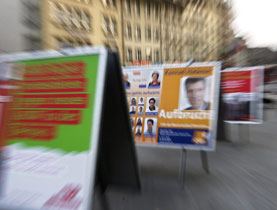
A very stable political spectrum

The Swiss political landscape is distinguished above all by its stability. Four parties dominate and all have been represented in government for decades.
Almost seven per cent of Swiss are members of a party. This is considerably more than in Germany but much less than in Austria, where one in five belongs to a political grouping.
All but one of the four big parties trace their roots back to the 19th century.
In 1894, the Radical Party was founded. It grew out of the liberal, radical and democratic movements that dominated the first decades of the federal state.
The Social Democratic Party had been founded when cantonal workers’ parties merged in 1888.
Later, at the turn of the century, conservative Catholics – the losers in the short civil war of 1847 – established what is now known as the Christian Democratic Party. The People’s Party, an association of farmers and artisans, was formed in 1936.
Protest parties
Numerous smaller parties exist next to the four main parties. The Liberals, anchored above all in French-speaking Switzerland, also date back to the 19th century. The Swiss Independents’ Party, which for a long time was the strongest force outside government, has disappeared.
The rest of the small Swiss parties are outgrowths of protest movements in the 20th century. Some remain firmly anchored at the regional and local levels, but at the federal level, neither the far left nor the far right play an important role.
The Green Party is the exception. An offspring of the environmental movement that gained strength in the 1980s, the Greens now are the strongest party not represented in the government.
Decentralization
The Radicals claim to be Switzerland’s largest political party, with 120,000 members, followed by the Christian Democrats at 100,000, the People’s Party at 85,000, and the Social Democrats at 34,000 (all figures as of 2007). The membership figures do not reflect the importance of the parties.
Decision-making in the parties is decentralized, for historical reasons. When the cantonal organizations of the largest Swiss parties created national committees, they were set up to ensure that local autonomy would not be threatened.
On important issues, the cantonal and local delegates’ votes at national party assemblies are decisive. Local autonomy also explains why sometimes different positions are taken publicly within the same party on the same issue.
Occasionally, the political styles within a single party can also differ. For instance, the Bernese faction of the People’s Party is seen as less rightwing and more moderate on social issues than its Zurich counterpart. Likewise, the People’s Party in Bern tends to present itself as a rural party of tradition, while in Zurich the focus is on economic liberalism.
Stability and change
From the time when parliament first was elected according to proportionality rules, 1919, until the late 1960s, there was remarkably little change in Swiss national politics. The four main parties each held the loyalty of its voters, polling consistent results year in and year out.
This ended with the entrance of new political parties around 1967. New leftist parties drew votes from the Social Democrats, and a new centre emerged.
Small far right parties rose to strength on an anti-foreigner platform in the late 1970s and the 1980s. Their influence waned when the People’s Party adopted some of their key policies in the 1990s.
The most defining change in the political landscape since the 1960s has been the rise of the rightwing People’s Party to become the strongest political party in Switzerland.
Previously, it had been the smallest of the four main parties, with one seat in the cabinet. During the 1990s, the People’s Party positioned itself as an opposition party from the right, voicing opposition to Switzerland’s opening up to international organisations like the UN and the EU.
After winning 27 per cent of the vote in 2003, the People’s Party claimed a second seat in the seven-member cabinet. The Christian Democrats, who had suffered at the ballot box, were forced to cede a seat to the People’s Party, who installed their emblematic head, Christoph Blocher, in the cabinet.
In 2007 the People’s Party increased its share of the vote to 29 per cent, posting the best result of a political party in Switzerland for nearly 90 years.

In compliance with the JTI standards
More: SWI swissinfo.ch certified by the Journalism Trust Initiative




























You can find an overview of ongoing debates with our journalists here . Please join us!
If you want to start a conversation about a topic raised in this article or want to report factual errors, email us at english@swissinfo.ch.